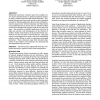Free Online Productivity Tools
i2Speak
i2Symbol
i2OCR
iTex2Img
iWeb2Print
iWeb2Shot
i2Type
iPdf2Split
iPdf2Merge
i2Bopomofo
i2Arabic
i2Style
i2Image
i2PDF
iLatex2Rtf
Sci2ools
UIST
1994
ACM
1994
ACM
Extending a Graphical Toolkit for Two-handed Interaction
Multimodal interaction combines input from multiple sensors such as pointing devices or speech recognition systems, in order to achieve more fluid and natural interaction. Twohanded interaction has been used recently to enrich graphical interaction. Building applications that use such combined interaction requires new software techniques and frameworks. Using additional devices means that user interface toolkits must be more flexible with regard to input devices and event types. The possibility of parallel interactions must also be taken into account, with consequences on the structure of toolkits. Finally, frameworks must be provided for the combination of events and status of several devices. This paper reports on the extensions we made to the direct manipulation interface toolkit Whizz in order to experiment two-handed interaction. These extensions range from structural adaptations of the toolkit to new techniques for specifying the time-dependent fusion of events.
Interface Toolkit | Multimodal Interaction Combines | Software Engineering | Twohanded Interaction | UIST 1994 |
| Added | 10 Aug 2010 |
| Updated | 10 Aug 2010 |
| Type | Conference |
| Year | 1994 |
| Where | UIST |
| Authors | Stéphane Chatty |
Comments (0)

